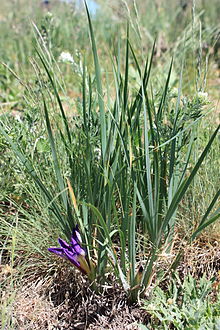Iris pontica
| Iris pontica | |
|---|---|
 |
|
| Scientific classification | |
| Kingdom: | Plantae |
| (unranked): | Angiosperms |
| (unranked): | Monocots |
| Order: | Asparagales |
| Family: | Iridaceae |
| Subfamily: | Iridoideae |
| Tribe: | Irideae |
| Genus: | Iris |
| Subgenus: | Limniris |
| Series: | Spuriae |
| Species: | Iris pontica |
| Binomial name | |
|
Iris pontica Zapal |
|
| Synonyms | |
|
|
Iris pontica is a species in the genus Iris, it is also in the subgenus of Limniris and in Series Spuriae. It is a dwarf rhizomatous perennial plant from eastern Europe, the Causcasus region and Russia, with a short stem and violet-blue and white flowers. It is cultivated as an ornamental plant in temperate regions.
It is known as the smallest Spuria iris. It is related to Iris sintenisii and Iris graminea but it is very distinct from them.
It has a short, thick, woody, branching rhizomes. That measure 0.4-1.0 cm in diameter. They normally grown at 3–5 cm deep in the soil. The branching and creeping habit creates tufts of plants.
It has foliage which is similar in form to Iris graminea. It has 2-5 basal leaves, that are narrow, linear, lanceolate, slightly glaucous and grass-like. They grow up to 10–45 cm (4–18 in) long and 2-5mm wide. The leaves can be 3 times as long as the stem. They have prominent ribs or veining.
It has very short stem, 1–4 cm long. In total, with the flower, peduncle and stem, the plant can reach up to 10 cm (4 in) tall.
The stems or peduncle hold 1 (or 2 rarely) terminal (top of stem) flowers, in late spring, or early summer, between April and June. The stems have 2 green, lanceolate, membranous spathes (leaves of the flower bud), that are 40-70mm long.
The flowers have a slight scent, which is rare for most spuria irises, and can be up 5–7 cm (2–3 in) in diameter, and come in shades of violet-blue, violet, purple, or purple-reddish.
It has 2 pairs of petals, 3 large sepals (outer petals), known as the 'falls' and 3 inner, smaller petals (or tepals, known as the 'standards'. The falls are sub-orbicular or obovate. They have a yellow, yellow-greenish or white centre patch that is veined with violet, reddish-brown or brown. They have very narrow dark purple claws (section closest to the stem). Measuring up to 45-55mm long and 15-18mm wide. The single coloured (violet-blue to blue) standards are oblanceolate and unguiculate (clawed). They also have a dark purple claws. Measuring 35-50mm long and 8-12mm wide.
...
Wikipedia
